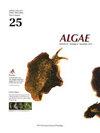普通异养原生生物对混合营养甲藻Ansanella granifera(苏科、藻科)的捕食
IF 2.4
3区 生物学
Q1 MARINE & FRESHWATER BIOLOGY
引用次数: 0
摘要
赤潮鞭毛虫因被捕食而导致的死亡率是影响其种群动态的一个主要参数。甲藻ananella granifera和ananella sp.偶尔会引起红潮。为了了解常见的异养原生生物与花青树之间的相互作用,我们研究了9种异养原生生物对花青树的取食情况,以及异养鞭毛藻对花青树的生长和摄食率随猎物浓度的变化规律,以及在单一高猎物浓度下,异养鞭毛藻对花青树的生长和摄食率。异养鞭毛藻Aduncodinium glandula、G. dominans、Gyrodinium moestrupii、Luciella masanensis、oboblea rotunda、O. marina、Polykrikos kofoidii、Pfiesteria piscicida和裸纤毛虫Strombidium sp.可以取食花心草。随着平均猎物浓度的增加,以花青花为食的优势蚁的生长和摄食速度迅速增加,达到饱和或缓慢增加。钉螺对花青花的最大生长和摄食率分别为0.305 d-1和0.42 ng C捕食者-1 d-1(3.8个细胞捕食者-1 d-1)。此外,在1700 ng C - mL-1(15454个细胞mL-1)条件下,金盏花的生长和摄食率分别为0.037 d-1和0.19 ng C -捕食者-1 d-1(1.7个细胞捕食者-1 d-1)。在甲酰鞭毛类食饵中,以花青花为食的G. dominans和O. marina的生长和摄食率几乎最低。因此,与其他鞭毛类动物相比,dominans和o.m arina可能更不喜欢花青花。花青花的低死亡率可能对其开花形成有积极影响。本文章由计算机程序翻译,如有差异,请以英文原文为准。
Feeding by common heterotrophic protists on the mixotrophic dinoflagellate Ansanella granifera (Suessiaceae, Dinophyceae)
The mortality rate of red-tide dinoflagellates owing to predation is a major parameter that affects their population dynamics. The dinoflagellates Ansanella granifera and Ansanella sp. occasionally cause red tides. To understand the interactions between common heterotrophic protists and A. granifera, we explored the feeding occurrence of nine heterotrophic protists on A. granifera and the growth and ingestion rates of the heterotrophic dinoflagellate Gyrodinium dominans on A. granifera as a function of prey concentration and those of Oxyrrhis marina at a single high prey concentration. The heterotrophic dinoflagellates Aduncodinium glandula, G. dominans, Gyrodinium moestrupii, Luciella masanensis, Oblea rotunda, O. marina, Polykrikos kofoidii, and Pfiesteria piscicida and the naked ciliate Strombidium sp. were able to feed on A. granifera. With increasing mean prey concentrations, the growth and ingestion rates of G. dominans feeding on A. granifera rapidly increased and became saturated or slowly increased. The maximum growth and ingestion rates of G. dominans on A. granifera were 0.305 d-1 and 0.42 ng C predator-1 d-1 (3.8 cells predator-1 d-1), respectively. Furthermore, the growth and ingestion rates of O. marina on A. granifera at 1,700 ng C mL-1 (15,454 cells mL-1) were 0.037 d-1 and 0.19 ng C predator-1 d-1 (1.7 cells predator-1 d-1), respectively. The growth and ingestion rates of G. dominans and O. marina feeding on A. granifera were almost the lowest among those on the dinoflagellate prey species. Therefore, G. dominans and O. marina may prefer A. granifera less than other dinoflagellate prey species. The low mortality rate of A. granifera may positively affect its bloom formation.
求助全文
通过发布文献求助,成功后即可免费获取论文全文。
去求助
来源期刊

Algae
PLANT SCIENCES-
CiteScore
5.10
自引率
25.00%
发文量
18
期刊介绍:
ALGAE is published by the Korean Society of Phycology and provides prompt publication of original works on phycology. ALGAE publishes articles on all aspects of phylogenetics and taxonomy, ecology and population biology, physiology and biochemistry, cell and molecular biology, and biotechnology and applied phycology. Checklists or equivalent manu-scripts may be considered for publication only if they contribute original information on taxonomy (e.g., new combinations), ecology or biogeography of more than just local relevance. Contributions may take the form of Original Research Articles, Research Notes, Review Articles and Book Reviews.
 求助内容:
求助内容: 应助结果提醒方式:
应助结果提醒方式:


